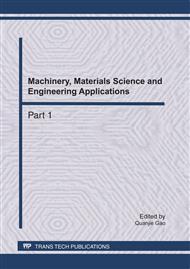p.299
p.303
p.309
p.315
p.321
p.327
p.332
p.340
p.345
Study on Lubrication Properties of Emulsion for Aluminum Cold-Rolling
Abstract:
Paper discusses that water content of emulsion has effects on the surface quality of cold-rolled aluminum alloy 5052 and higher concentration of emulsion gave thicker lubrication film and better surface quality of aluminum strip. When the speed of rolling reaching a critical speed, thickness of emulsion film will decrease with time. Film forming of emulsion shows that when rolling speed is low, properties of emulsion is similar to that of oil, while when speed reaching a critical value, mechanism of lubrication in rolling work zone will change from plate-out model suitable for low rolling speed to starvation model suitable for high rolling speed .This paper also discusses friction model for cold-rolling, and explains that the contact length of work zone and strip and forward slip get greater with rolling reduction increasing , which easily result in lubrication failure in the work zone.
Info:
Periodical:
Pages:
321-326
Citation:
Online since:
April 2011
Authors:
Price:
Сopyright:
© 2011 Trans Tech Publications Ltd. All Rights Reserved
Share:
Citation:


